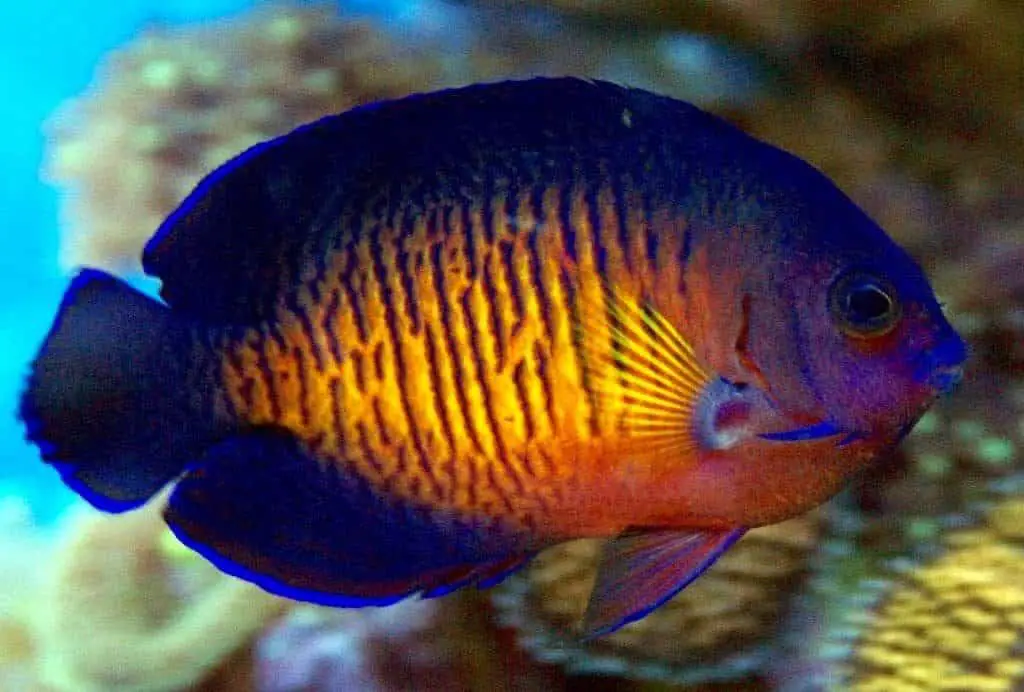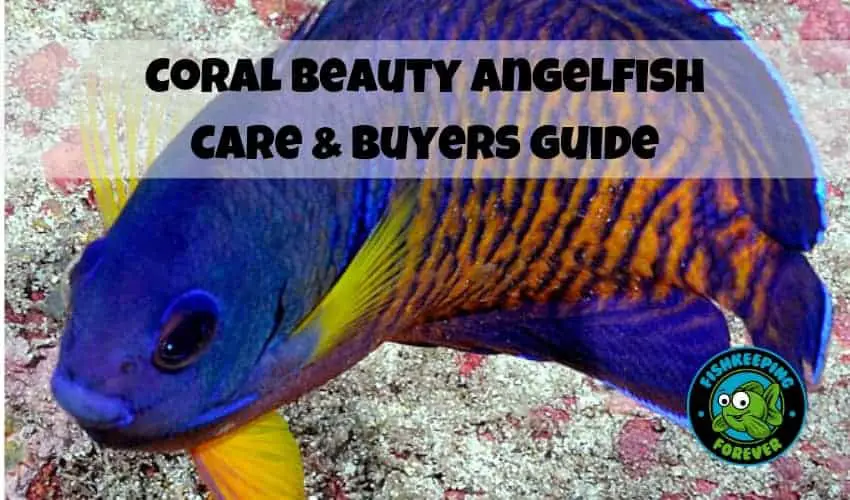The Coral Beauty Angelfish or (Centropyge bispinosa) if you like to use their scientific or Latin names are one of my all-time favorite saltwater fish. This saltwater dwarf angelfish was one of the first saltwater fish that I ever purchased and added to my coral reef tank which was a 100-gallon aquarium packed full of living rock and an assortment of peaceful saltwater fish.
Why did I choose a coral beauty angelfish first?
It was for a couple of reasons, firstly for its beauty ( Hence the name) their colors and patterns are incredible for such a small angelfish. The striking iridescent blue on the edge of their fins looked incredible both at night and day when the light catches them. That against the bright red/orange body looks amazing. Secondly, I liked their size, price and behaviors. They have a very inquisitive nature and roam the whole tank looking for food and places to explore, combine this with their peaceful nature means they are perfect for a peaceful community saltwater aquarium.
Let’s have a look at these fish in more detail and see if they will be suitable for your aquarium.
Table of Content
- Origins
- Appearance & Behaviours
- Reef safe?
- Diet
- Breeding
- Care Needs
- Aquarium size
- Suitable tank mates
- Conclusion
- References
| Scientific Name | Centropyge bispinosa |
|---|---|
| Family | Pomacanthidae |
| Temperament | Peaceful |
| Care Level | Easy |
| Diet | Omnivore |
| Reef Safe | With Caution |
| Size | 4" |
| Tank Size | 70-80 Gallons Plus |
| Price | $50 |
Table of Contents
Origin of the Coral Beauty Angelfish
This dwarf angelfish is common in and around the Great Barrier Reef and the Indo-Pacific ocean. The Coral Beauty Angelfish is also known as the Twospined or Dusky Angelfish and can be found in the shallow waters of Fiji and Indonesia.
It can be found in shallow reef areas and lagoons where it can be found grazing on algae. There is also a deep water species of this fish that can be found in deeper open waters. But this smaller 3-4″ species will very rarely venture out into open water or stray away from the shallow food rich areas of the reef and lagoons.
The colors of individuals species may vary considerably, some predominantly more purple or orange depending on their origin. The coral beauty will adapt quickly to the home aquarium and will soon settle down into their new home.
Appearance & Behaviours
You can easily see where the Coral Beauty Angelfish gets its name from. Its body and head are a deep royal blue, highlighted with an iridescent blue edge to their fins and a bright red/orange body. The Coral Beauty Angelfish is one of the easiest angels to care for and suitable for smaller aquariums of around 70-90 Gallons due to the fact that they only grow to an adult maximum size of 4″.
These fish will continually pick at any particular sessile invertebrate and cause damage or death. Like most other members of the Centropyge genus, the Coral Beauty does not grow very large, but still needs a medium size aquarium with plenty of open water to swim in and plenty of hiding places and rocks in pick algae from.
It is not classed as reef safe but has been known to live in reef aquariums if the correct diet and feeding times are followed. We often get asked what’s the best time to feed your fish but that is a difficult question to answer as most fish require different types of fish foods and need to be fed different amounts.
Is the Coral Beauty Reef Safe?
To be 100% sure we would have to say the coral beauty is not reef safe due to the facts mentioned above that they can and often do nip and peck at stony and soft corals (sessile invertebrates).
Despite the name Coral Beauty most aquarium stores will not recommend adding them into a reef aquarium as will tell you that they will nip and eat all your corals but I have found that they are normally more interested in eating the algae within the aquarium and leave my corals and invertebrates alone.
We can’t guarantee this and you would have to make the decision for yourself but we have found many people who share our experiences. Watch the video below and you’ll see what we mean about how they normally just go round eating the algae as they are omnivores.
Diet
The diet of the Coral Beauty Angelfish should consist of algae first an foremost but they will also accept Spirulina-enriched brine shrimp, Mysis shrimp, special sponge-based Angelfish preparations, and finely chopped krill/squid/cockle/mussel.
Mine loved the seaweed strips like the OmegaOne Super Veggie Green Seaweed available from Amazon which I held in place with a saltwater safe food clip also available from Amazon.
Like most omnivores, these fish will eat almost anything including meaty foods which lots of people often think omnivores won’t eat.
Feeding the coral beauty is varied and quality diet is the key to their success in the home aquarium. In the wild they have a huge variety of food sources to feed on and limiting them in the home aquarium to one or two foods is just wrong and cruel in our opinion.
As responsible aquarists, we have a duty of care to any creatures we keep and giving them the best possible diet no matter what the cost is the right thing to do.
We have a complete guide to different types of fish food that you may find helpful which explains the difference and benefits of each type of fish food. Everything from Freeze dried, flake, pellet, and live foods are covered. There are also some helpful homemade fish food tips which we find fascinating. I love creating my own fish food, I know 100% what’s in it and I can rest assured I’m giving my fish the best and freshest fish food possible.
Breeding Coral Beauty Angelfish
This egg scattering species is unlikely to breed in the home aquarium due to the fact that most home aquariums are too small to house more than one species of coral beauty without them fighting for territory. This makes breeding them almost impossible.
Each year thousands of these fish are caught and shipped across the world as one of the most popular saltwater aquarium fish which can put a strain of the environment. But great news, these species of fish have been captive bred in a specialist facility called BiotaPalau.com. You can visit their website and see the amazing work they are doing to breed more and more saltwater fish for the home aquarium.
What’re the benefits of captive breed fish?
The benefits are a hardier fish more suitable and easier to acclimate into the home aquarium. They are fed a type of food that most home aquarists will be able to get which makes acclimatizing and feeding these fish easier. They are disease free and travel better than most wild-caught species.
Breeding these in captivity is still a million miles away from breeding them in the home aquarium and to our knowledge, they haven’t been breed very often in a home aquarium. We only know of one or two succesful attempts.
Baby captive breed coral beauty is silver in color and only start to be recognized as the colorful dwarf angelfish we know from around 3 months when their colors start to come through on their heads and neck area first.
Care Needs
This is a hardy pygmy angelfish that is generally resistant to disease and a relatively peaceful fish. They require an aquarium around 70 Gallons with water parameters of 72-81° F, pH 8.0-8.4, sg 1.023-1.025.
The best way to prevent these fish from developing a disease is to give them the best water quality possible in a peaceful aquarium with plenty of places to hide. This will reduce the stress level which will help prevent diseases from forming.
Angelfish of the genus Centropyge often come into this country harboring parasites so quarantining them before adding them into your main aquarium is really important. If this isn’t possible make sure you inspect the fish in the aquarium or pet store carefully before purchasing. Ask to see the fish feeding and take your time buying it to ensure you are purchasing a fit and healthy specimen. Many stores will apply a copper-based medication while in quarantine to kill any parasites before going on sale.
The coral beauty isn’t very aggressive and definitely not as aggressive as some members of the family. However, this fish will become territorial if newcomers are added to the tank after it has become established especially if they are very shy and placid fish and therefore we advise that when adding a Coral Beauty in your stock list, it should be added to the aquarium last
You will need to provide lots of rockwork with many caves and crevices to hide in. This will provide security, and the more secure the fish feels, the more it will come out into the open and show off its beauty. Plenty of live rocks will provide places for algae to grow which is vital for their survival.
A strong current isn’t an issue for this fish as it is a strong and powerful swimmer even for a dwarf angelfish. They constantly swim and hardly ever slow down. They have a fantastic personality and make for interesting fish to watch.

Aquarium size
A 70 Gallon+ aquarium is is a minimum with plenty of rocks, caves and hiding places.
Ensure you have a cover or lid on the tank when you first introduce this fish into the tank. They have a tendency to panic when first introduced into the aquarium and often jump out of the tank with fear. They swim fast and enjoy a strong current and can compete with strong feeders in the aquarium. For such a small fish they are powerful swimmers and once they have settled down they will become confident and start to explore all areas of the aquarium.
Fish keeping has many health benefits and watching lovely, colorful fish like these can greatly reduce stress.
Ensure you have the best quality water possible and try to use RO-DI water if possible. This will help control the water parameters when you perform water changes.
Suitable tank mates
Coral beauty angelfish can be kept with many other saltwater species and only become territorial with other angelfish so your choices of tank mates are endless.
I kept mine with a pair of Picasso Clownfish, dwarf lionfish, mimic saddle filefish, Foxface and other peaceful saltwater fish.
Even though this is a dwarf angelfish it is very hardy species and can look after itself against larger fish in the home aquarium. It’s a very active fish and can compete with other stronger fast feeders and will not go short of food at feeding times.
The male is generally larger than the females, but the color is not necessarily an indication of sex. Like all Centropyge, these fish are all born as females. When they grow in a large group, the larger and more dominant fish will become male and the others will remain female. If the male dies, the next dominant female in the hierarchy will turn to male. Putting a larger and smaller fish together is the best way to get a pair, possibly in about 2-3 months.
Conclusion
Coral Beauty Angelfish are one of the most colorful and interesting saltwater fish you can keep in the home aquarium. They are constantly on the move and looking for food. They interact well with other fish and are very easy to feed and keep.
If you want a stunning fish that is inexpensive, easy to care for and looks amazing then we highly recommend buying a Coral Beauty Angelfish.
Let us know if you have one or if you’re thinking of getting one. We’d love to hear from you.
Happy Fishkeeping Forever!

I have been working in the tropical fish industry for over 30 years now and I’m still learning. Everyday is a school day in this hobby. In my spare time I play golf very badly!



